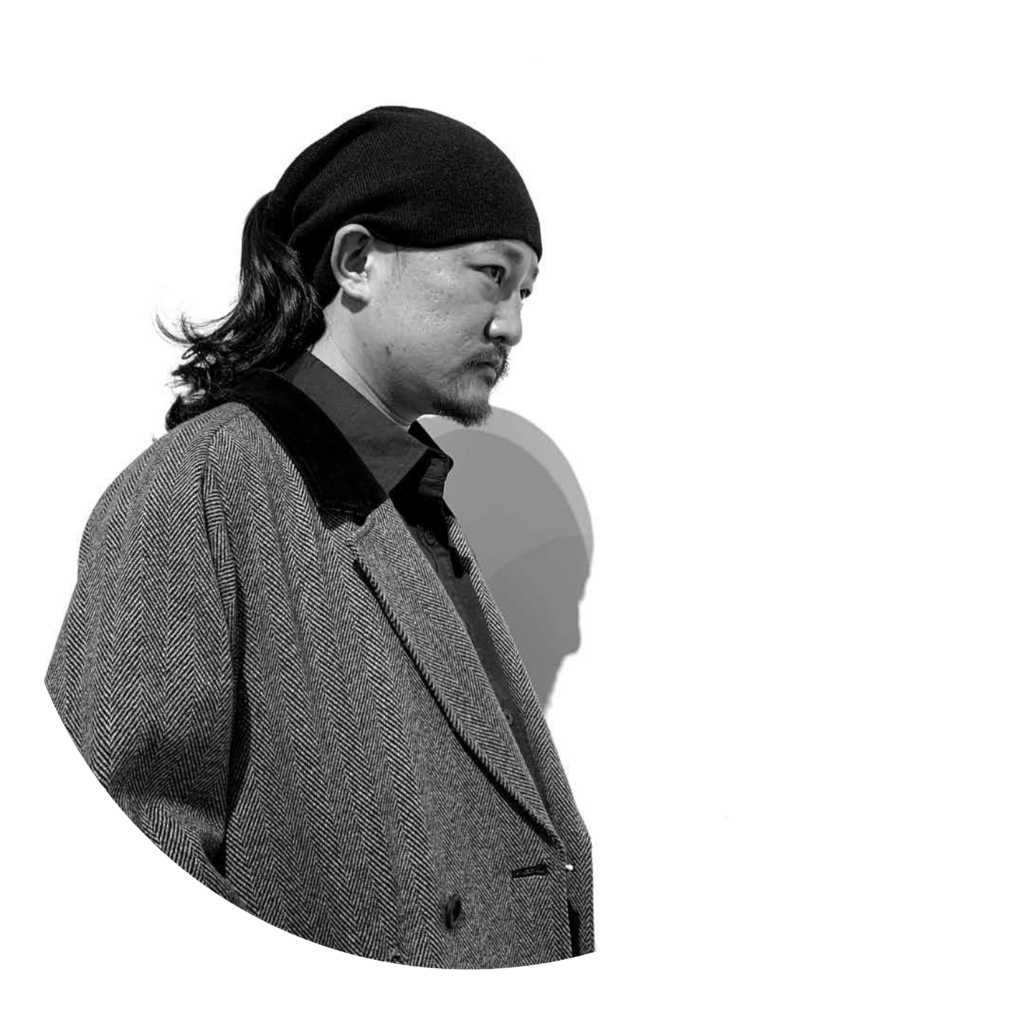多幕:作为复数的行动 ——关于王彦鑫的行为影像“西北叙事” “Multiple Acts: Plural Actions — On Wang Yanxin’s Performance Videos Northwest Narrative”

罗菲 Luo Fei
批评家,策展人 Critic, Curator
文/罗菲 2025.09
多幕:作为复数的行动 ——关于王彦鑫的行为影像“西北叙事”
1
清晨七点,青海湖东岸一栋废弃工厂屋檐下,成群的乌鸦在此躲雨。
昏暗房间里悬挂着一件白衬衫,衣服上方有一个通往外部的圆洞。来自甘肃的艺术家王彦鑫赤裸上身,脸上配有羽毛的面具。他在这里不停放飞棍状的彩色气球,他试图让气球击中那个洞,或者借用气球泄气的劲让气球从那个洞逃脱出去。气球像无头苍蝇一样在屋里乱串,伴随着啸叫声。
另一个厂房空间,王彦鑫挎着当地社火表演用的太平鼓有节奏的踱步和拍打,不时高举即将熄灭的火炬。暗不见光的房间里,他将一连串装有蜡烛的玻璃瓶系在脚踝,拖着它们缓步前行,玻璃瓶在地面相互碰撞发出清脆声响,然后逐个掉落地面缝隙中。他不断敲击手中的牛骨,在烛光中反复揣摩人体骨架(模型),又让它们如同提线木偶一样跟随艺术家的身体一起跳动……
这一系列画面来自王彦鑫称作“西北叙事”的第一部《金银滩》。艺术家采用多幕剧的形式在不同场景切换,每部影像由八九个场景和行为表演构成。艺术家在这部影像里的行为显得较为谨慎和隐忍,他在保持观察,尝试做出一些反应。
这部作品拍摄于青海金银滩草原的工业遗址。上世纪五十年代,这里曾是核武研制基地,我国第一颗原子弹和氢弹诞生于此。在长达半个世纪的时间里,这个地方不为外人所知,众多科研先驱和建设者在此隐姓埋名几十年,金银滩由此蒙上浓重的神秘色彩。而历史上的西北戈壁,也因其严酷的生存环境,常被当做政治惩罚的流放之地。
近些年,王彦鑫时常以历史遗迹作为身体行动的场域,在重返地方的行动中他将环境转化为人的某种处境或遭遇,让肉身展开一系列命定般的自我陈述。多幕剧式的影像则让那些来自不同时间、不同场域、不同着力点的行动形成有关身体与空间、历史、文化相互碰撞和交缠的叙事结构。
2
时间从下午一点半调整到四点。每部影片都以艺术家拨动胸前的时钟作为开始。
青海湖北岸的某农场旧址。炙热又单调的戈壁滩。
夕阳下残垣断臂修长的阴影和牧民的牛,戈壁上的时间仿佛停滞在历史长河中的某刻。
一段斜坡上,远远望见艺术家舞动着一对社火表演用的瑰红色扇子,他小心翼翼从斜坡一头挪动到另一头。接着又缓缓展开一段三十米长的金色风马旗。
画面来到一段铁轨上,王彦鑫拖着一堆口缸退行,同时快速拨动指针倒转。拖行的口缸在铁轨上相互碰撞叮咚作响。在一扇铁门前,他掏出口琴,缓缓吹响《在那遥远的地方》。这是王洛宾在上世纪三十年代创作的“草原情歌”,曾被广泛传唱。这是一曲有关草原、骏马和爱情的远方想象。优美动人的乐曲宛如哀伤的乡愁回荡在戈壁铁轨上。
时间随指针倒流,情绪从历史缺口处倒灌。
夜幕降临,王彦鑫站在一栋陈年红房子前的雕塑基座上,以他最饱满的热情持续挥舞一条长长的发光的红龙,形如挥舞一张胜利的大旗,祝贺凯旋而归的英雄,又仿佛是对往昔的持续召唤。一列运煤火车从背后驶过,历史与当下在此刻交汇。
这是“西北叙事”的第二部,名为《在那遥远的地方》。对艺术家而言,无垠戈壁既是曾经离开之地也是现在抵达之地,是遗落在历史深处的隐秘之地,也是搁浅在“草原情歌”上的故乡。这一次,行动开始变得具有仪式感和象征性,身体也被赋予历史豪迈感。乡愁如泉水从戈壁荒漠里涌出。
3
第三部名为《朱砂玉》,那片沙漠的名字。
艺术家的身体在沙漠草丛里随风歪斜。
他在广袤的沙漠上缓步前行,肩上配有黑色羽毛的护肩,脸上有白色羽毛面具,系在腰间的金色飘带在身后随风飘扬,犹如凯旋而归的战士,豪迈而笃定。他站在沙丘顶峰,瞭望荒芜戈壁,吹响手中号角。号角没有想象中那么洪亮,这里也没有迎接他的跟随者。他只是孤身一人行走在广袤的沙丘上,俨如一名被遗忘在此地的古代流放者。
在另一处沙丘上,他放飞一张写有“如日中天”的巨大风筝。
他又赤身露体,在沙丘上反复爬坡,然后滚下。西西弗式的重复与疲劳。
黑夜来临,他在荒漠里演奏着一架燃烧中的小提琴,同样是一曲脍炙人口的曲子——意大利游击队歌《啊,朋友再见》。“如果我在战斗中牺牲,你一定把我埋葬在高高的山岗”。音乐中洋溢着浪漫欢快的气氛,也充满英雄气概。伴随着来自荒漠的风噪声,艺术家沉醉在属于自己的舞步时刻。历史在此刻如遥远的星辰在夜幕中退去,艺术家独自与火焰、戈壁、夜幕共舞。
从清晨到入夜,从幽闭空间到辽阔戈壁,从隐忍前行和不确定的踱步到荒漠上吹响号角和恣意舞步,王彦鑫在一系列富有历史意味的场域和戏剧性的行动中,完成了属于他自己的“西北叙事”,或者说“自我流放”。
4
这三部多幕剧式的行为影像为王彦鑫在行为艺术方面的探索提供了新的可能。不局限于现场表演的唯一性,他将行为艺术与影像叙事结合,将身体作为不断介入的行动放到不同场域里,又以角色化的形象出现,让作品富有层次感和戏剧性。在这里,身体作为复数的人轮番出场,他们可能是跳社火的民众、敲打牛骨的示威者、高举火把和号角的英雄,或者在戈壁上被放逐的裸命者……
从日本福岛到云南抚仙湖再到重庆废弃煤厂及至西北戈壁,王彦鑫近些年选择创作的每个地点都有其特殊的地方性和历史维度。他并没有在影像里直接给出地方线索,也没有将它们作为研究对象或者作为背景来使用,而是将其作为一系列处境来处理,探讨人在其中可能面临的境况,以及人在这些境况里所具有的感知力和行动力。这些感知和行动有些鬼魅、荒诞、诗意、富有象征性和英雄气概,同时也比较魔幻现实。
王彦鑫会在行为作品中使用当地废弃物和表演道具,也会使用脍炙人口的音乐,好让整个行动看上去像是剧场表演。区别于一般意义上的行为表演(performance),行动(action)具有更加明确的诉求和公共性。汉娜·阿伦特(Hannah Arendt)曾将劳动、工作和行动看作人类三种根本性的活动,它们代表着积极生活。行动意味着人的能动性,意味着拒绝成为裸命者。尽管行动不能被表演所取代,但王彦鑫依然以表演的面目出场,以获得一种虚构的陈述,它与地理环境、空间尺度、历史印记、民俗表演、象征物、地方认同以及当下的身体感知和情绪形成叠层,正如多幕影像这种结构所呈现的那样,一系列复数的行动被时间紧紧挤压在一起。
在王彦鑫这里,身体既是容器也是内容。身体承载历史,也是历史中的身体,任其搅动和激荡。他所能做的,就是在其中保持行动,保持复数的行动。
"Multiple Acts: Plural Actions — On Wang Yanxin’s Performance Videos Northwest Narrative"
1
At seven in the morning, under the eaves of an abandoned factory on the eastern shore of Qinghai Lake, a flock of crows huddled together, seeking shelter from the rain.
Inside the dim room, a white shirt hung from the ceiling. Above it was a circular hole leading to the outside.
The artist Wang Yanxin, originally from Gansu, stood bare-chested, his face hidden behind a mask adorned with feathers.
He kept releasing long, stick-shaped balloons in bright colors, trying to make them fly through the hole or escape through it as the air leaked out.
The balloons flitted about the room like frantic flies, filling the space with whistling sounds.
In another factory room, Wang carried a Taiping drum — a traditional prop used in local festive performances — pacing rhythmically while striking it, occasionally lifting a dying torch high into the air.
In a lightless chamber, he tied a series of glass bottles with candles inside to his ankles and dragged them slowly across the floor.
The bottles clinked against one another and eventually slipped through the gaps in the floorboards.
He struck a cow bone again and again, studying the skeletal model of a human body illuminated by candlelight, making it sway like a marionette in sync with his own movement.
These images are from Jinyintan, the first chapter of what Wang calls his “Northwest Narrative.”
The video unfolds like a multi-act drama, switching between eight or nine distinct scenes of performance and environment.
Here, the artist’s movements are cautious, almost restrained — as if in observation, testing how to respond.
The work was filmed amid the industrial ruins of Qinghai’s Jinyintan grasslands.
In the 1950s, this was the site of China’s first nuclear weapons research base, where both the atomic and hydrogen bombs were developed.
For nearly half a century, the place remained a national secret; generations of scientists and builders lived and worked here in anonymity.
Jinyintan became shrouded in mystique — as did much of the Northwest’s barren landscape, long used as a site of political exile and punishment.
In recent years, Wang Yanxin has repeatedly chosen historical ruins as his sites of bodily intervention.
Through these returns to specific places, he transforms the environment into a metaphor for the human condition — a confrontation with fate, loss, and endurance.
His multi-act structure stitches together actions from different times and locations into a narrative web where body, space, history, and culture collide and entangle.
2
The time shifts from 1:30 to 4:00 in the afternoon.
Each film begins with the artist adjusting the clock hanging on his chest.
At the site of a former farm on the northern shore of Qinghai Lake, the scorching Gobi stretches endlessly.
In the setting sun, the ruins cast long shadows beside the cattle of passing herders; time on the Gobi seems frozen somewhere in history.
On a slope, the artist waves a pair of crimson fans once used in local folk performances, moving carefully from one end of the incline to the other.
He then unfurls a thirty-meter-long strip of golden wind-horse prayer flags.
On a railway track, Wang drags a cluster of clay jars backward, spinning the clock’s hands in reverse as he moves.
The jars collide along the iron rails with rhythmic metallic clinks.
Before an iron gate, he takes out a harmonica and slowly plays In That Distant Place — a 1930s folk song by Wang Luobin, a classic “grassland ballad” about love, horses, and faraway dreams.
Its melancholy melody drifts across the Gobi like an elegy for memory itself.
As the clock rewinds, emotion floods back through the cracks of history.
At dusk, Wang stands atop a pedestal before a timeworn red building, waving a long, glowing red dragon — at once a victory banner celebrating the triumphant hero, and a lament calling to the lost past.
A freight train rumbles by behind him, loaded with coal; history and the present converge for an instant.
This is In That Distant Place, the second part of his “Northwest Narrative.”
For the artist, the vast Gobi is both the place once left behind and the destination reached again — a hidden geography buried deep in history, a home stranded in the echo of a song.
Here, Wang’s actions acquire a ritual and symbolic gravity; the body takes on the grandeur of history itself.
Nostalgia wells up from the desert like a spring.
3
The third piece, Shazhuyu (“Cinnabar Jade”), takes its name from the desert itself.
Wang’s body bends in the wind among the dry shrubs.
He walks slowly across the vast dunes, wearing black feathered shoulder guards and a white feather mask, with a golden ribbon tied to his waist trailing behind him like a victorious warrior returning from battle.
Standing atop a dune, he surveys the barren horizon and blows a horn.
The sound is faint — no followers, no chorus.
He walks alone across the sand like an ancient exile forgotten by time.
On another dune, he releases a giant kite bearing the phrase “Radiant at High Noon.”
He strips naked, crawling up and rolling down the slope again and again — a Sisyphean cycle of exhaustion and persistence.
As night falls, he performs on a burning violin, playing the Italian partisan song Bella Ciao.
“If I die in battle, bury me high on the mountain.”
The music brims with romantic heroism, mingling joy and tragedy.
Amid the desert wind, the artist loses himself in his own choreography — a solitary dance with fire, with the desert, with the night.
History, like distant starlight, recedes into darkness.
From morning to night, from confined interiors to the vast Gobi, from hesitant motion to triumphant movement — Wang Yanxin completes his “Northwest Narrative”, or perhaps his “self-exile.”
4
This trilogy of multi-act performance videos opens new possibilities for Wang’s exploration of performance art.
Freed from the constraints of live immediacy, he merges action and cinematic narration, situating the body within diverse environments and reappearing through shifting roles.
Each persona — the festive dancer, the bone-beating protester, the torch-bearing hero, the exiled wanderer — enriches the work’s layers of meaning and theatrical complexity.
From Fukushima to Fuxian Lake in Yunnan, from abandoned coal plants in Chongqing to the desolate Gobi of the Northwest, every site Wang selects carries distinct local and historical dimensions.
Yet he never treats them as mere research subjects or narrative backgrounds.
Rather, he translates place into condition — probing how human beings perceive and act within it.
His gestures are ghostly, absurd, poetic, and symbolic — sometimes heroic, sometimes surreal.
He incorporates local debris and folk props, familiar popular music, and elements of ritual, giving his performances a theatrical illusion.
Unlike conventional “performance,” Wang’s actions (xingdong) possess a sharper intentionality and public resonance.
As Hannah Arendt once wrote, labor, work, and action are the three fundamental human activities that constitute an active life.
Action embodies human agency — the refusal to become a “bare life.”
Although action cannot be replaced by performance, Wang uses performativity as a means of fictional narration, layering it with geography, spatial scale, historical residue, folk culture, symbolism, local identity, and the immediacy of bodily emotion.
Like the structure of his multi-act videos, these plural actions compress multiple times and realities into a dense, living fabric.
In Wang Yanxin’s work, the body is both vessel and content.
It carries history and is carried by history, stirred and reshaped within it.
All he can do is to keep acting — to sustain multiplicity through action.
// 最近新作Recent Post
// 分类Categories

1988年生于甘肃兰州,2013年毕业于四川美术学院新媒体系,现工作生活于成都,任教四川文化艺术学院,副教授。
Wang Yanxin, born in 1988 in Lanzhou, Gansu, China. graduated from Sichuan Fine Arts Institute in 2013. Since 2012, he has been engaged in multimedia artistic creation based on performance art. He currently lives and works in Chengdu and is a professor at Sichuan Conservatory of Culture and Arts.
- Chengdu, Sichuan, China
- +86 15215015022
订阅Newsletter
Copyright by wangyanxin.com. 版权所有.

-1.png)
